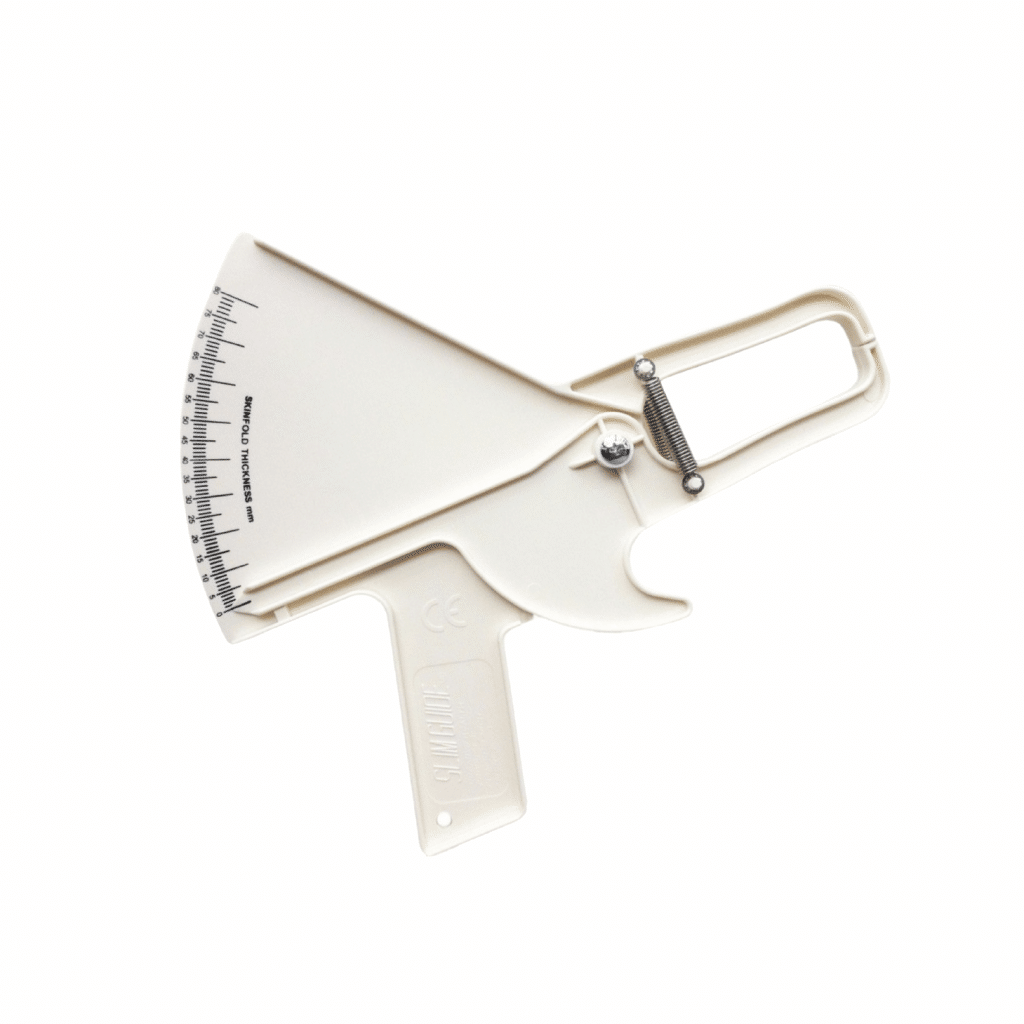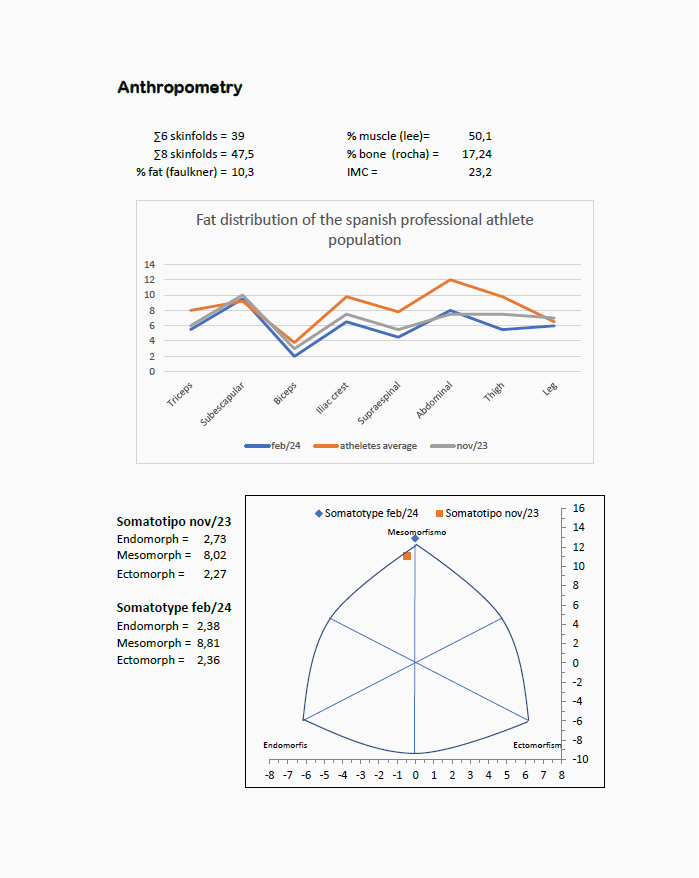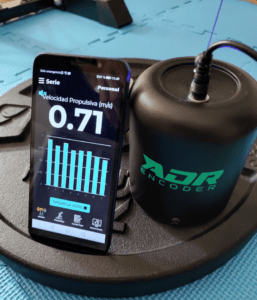Table of Contents
- Ideal weight in Cycling
- Anthropometry
- Ranges to assess weight in the general population
- How to assess the body composition in cycling
- Bibliography
Ideal weight in Cycling
Weight in cycling is a critical factor that significantly influences the performance and efficiency of cyclists. The importance of weight is evident both in the bicycle and in the cyclist’s own body. The weight of the cyclist is crucial, as a lighter body requires less energy to move, resulting in greater endurance and the ability to tackle longer distances on demanding terrains allowing also for greater speed during climbs. Additionally, controlling body composition and weight is fundamental for maintaining a balance between muscular strength and power, thus maximizing performance in cycling. In the world of cycling, the importance of weight is not simply limited to numbers on a scale but translates into tangible improvements in performance and the cyclist’s ability to face the challenges presented on the road. If you want to go into more detail about the forces that affect the cyclist when moving on the bike, take a look at my previous article here.
One of the values that is often looked at is the ability to produce a certain power in relation to the cyclist’s weight, the famous watts/kg. Basically, for two cyclists of the same height and weight, the cyclist who can produce more watts/kg on a climb will go faster. Hence, in some cases, cyclists try to lose some weight to maximize this ratio. For example, for a cyclist who can climb at 4W/kg, losing one kilogram of weight would be equivalent to producing an extra 4 watts with the same weight, and losing 2 kilograms would mean 8 watts more. This may seem like a small improvement at first glance, but a loss of 2 kilograms would translate to a 3% improvement in watts/kg. For a cyclist weighing 70 kilograms who has lost 2 kilograms, this would mean climbing a hill that previously took 1 hour in 58 minutes and 50 seconds (1 minute and 10 seconds less).
Another point where weight is important is when we have to make many accelerations on the bike (whether on flat terrain or uphill). For example, in XCO races or criteriums where we have to accelerate after each turn, in sprints, or in attacks. The second law of Newton (F = ma) tells us that the acceleration of an object depends on the force applied and the mass of the object, therefore, with the same applied force, acceleration will be greater if less weight needs to be moved.
However, we must be careful when trying to lose weight because in all the previous cases we mentioned that there is an improvement in performance with weight loss as long as there is no loss of strength or power. And this point is very important because we must ensure that the weight loss is primarily fat tissue and does not affect our performance or health. To lose weight, one must be in a caloric deficit. In this state, the body does not receive all the macronutrients it needs, so it uses its most important and abundant energy reserves, which is the fat tissue. Being in a caloric deficit also entails poorer recovery and greater metabolic stress on the body, so it is important to plan it well within each athlete’s annual plan to choose the ideal moments to not impair our cyclist’s performance. Furthermore, losing more weight is not always the answer because we must ensure that the athlete has a minimum healthy fat level. Fat is not only used as an energy source; it also serves very important functions such as thermal insulation, transport of fat-soluble vitamins, being an indispensable structural component of cells, and serving as precursors to certain hormones.
With all this, a question arises: should I lose some weight? And if so, how much? The answer lies in knowing our body composition and contrasting this data with performance metrics (power production, strength, etc.).
Anthropometry
Anthropometry, derived from the Greek words “anthropos” (human) and “metron” (measure), has a rich history deeply rooted in our quest to understand the human form. It is a discipline that deals with measuring and analyzing the physical dimensions and characteristics of the human body.
Anthropometrists select specific measurements that are considered relevant for the purpose of assessment. These may include lengths, widths, diameters, circumferences, and skinfold thicknesses of various body parts. Various measuring instruments are used depending on the technique employed. Some examples include calipers for skinfold measurements, tape measures for measuring circumferences, scales for measuring body weight, and anthropometers (for measuring bone diameters or widths).
Measurements are taken in a standardized manner to ensure consistency and comparability between different individuals. This involves following specific procedures, such as using common anatomical landmarks and applying consistent measurement techniques. For example, to measure the triceps skinfold, one must locate the midpoint of the arm (elbow-shoulder segment) and then find the projection to the triceps area.
Once the measurements are collected, the data is interpreted to provide information about body composition, fat distribution, growth, development, and other relevant aspects. Comparing the results with established standards or reference populations can help assess health and performance.
Anthropometry is a valuable tool in fields such as medicine, nutrition, sports performance, and scientific research. It provides objective information that can be used to assess health status, design personalized training programs, monitor growth and development, and conduct epidemiological research. It is important to emphasize that anthropometry should be carried out by trained professionals and following standardized protocols to ensure the accuracy and validity of the results.
There are various techniques for measuring different aspects of the body. Some of the most common ones include:
Bioelectrical Impedance Analysis (BIA):
Measurement of the body’s electrical resistance to estimate body composition. It assesses the percentage of lean mass, percentage of fat mass, and percentage of bone mass in addition to body weight.
Characteristics: BIA is the quickest and non-invasive option, commonly used in households and clinical settings. However, it is also the least precise method and may show variations depending on the body’s hydration level/fluid retention.
Dual-energy X-ray Absorptiometry (DXA or DEXA):
The use of X-rays to measure bone density and body composition. It accurately measures subcutaneous fat, visceral fat, and their distribution, as well as muscle mass in different body segments. Additionally, it provides other measurements such as bone mass, bone density, or body weight.
Characteristics: Considered the “gold standard” highly accurate method, commonly used in research and specialized clinics. It is very reliable but also highly expensive and not frequently performed due to X-ray exposure (frequent exposure to X-rays could be harmful to health).
Skinfold Caliper Measurement:
The chosen option at JS Cycling Training: Measurement of skinfold thickness using a caliper to estimate subcutaneous fat, along with the addition of circumferences to estimate muscle mass and diameters to estimate bone mass.

Characteristics: A common method in sports and health environments, it is more economical but requires some knowledge from the person conducting the measurement to obtain reliable results. It is more reliable than bioimpedance but less so than DXA, without negative consequences as you can see in this article.
Conventional Anthropometric Measurements: These include measures such as height, body mass, waist circumference, hip circumference, etc.
Ranges to assess weight in the general population
Body Mass Index (BMI) is the ratio of weight to height. It is calculated by dividing weight by the square of height (in meters). Thus, a cyclist who is 1.8m tall and weighs 70kg has a BMI of: 70/(1.8^2) = 21.6.
It is a general indicator of health but limited in assessing body composition since it only considers height and weight and not what this weight consists of. Someone with a healthy BMI (for example, 24) but low muscle mass would be in poor health as they would likely be accumulating a significant amount of fat, and the lack of muscle mass would indicate a sedentary lifestyle and thus low metabolic health. Therefore, one must know how to use its values, which are intended to be an easy-to-use and very economical tool but also very basic and not very applicable in high performance settings. Due to its simplicity, it can be a good option for the general population to determine their optimal weight and for sedentary individuals, in particular, to determine if they are overweight or not.
Normal Range: 18.5-24.9 -> the majority of the athletic population, 100% of endurance cyclists (road cycling and MTB (XCO, XCM)).
Underweight: Less than 18.5.
Overweight: 25-29.9.
Obesity: 30 or more.
In the case of endurance cycling (road, XCO, and XCM), cyclists typically have a BMI between 19 and 23. Road or XCM climbers are the lightest (in the range of 19-21), XCO cyclists fall in an intermediate range (19.5-22), and sprinters are at the higher end of the range (21.5-23).
Body Fat Percentage:
The optimal ranges for body fat percentage vary depending on various factors such as age, sex, level of physical activity, and individual goals. Here are some general guidelines for reference values of body fat percentage, in terms of health and performance:
Health:
For men:
Normal Range: 10-20%
Acceptable Range: 21-24%
Obesity: More than 25%
For women:
Normal Range: 18-28%
Acceptable Range: 29-32%
Obesity: More than 33%
High Performance:
For endurance athletes: 5-15%
For strength athletes: 8-20%
How to assess the body composition in cycling
In the case of high-performance cycling, it will be more crucial to aim for lower values in cases where potential loss of muscle mass (with weight loss) is not a very detrimental factor, for example, climbers or riders in grand tours. For these types of cyclists, having a large amount of muscle mass, especially in the upper body, is not an important factor, and losing weight may bring more benefits than losses. On the other hand, more explosive cyclists such as XCO (MTB) riders or road sprinters may likely have higher body fat percentages as they do not want to compromise their muscle mass, which could make them lose explosiveness and, consequently, races. Additionally, it’s important to individualize these values based on each individual, as some cyclists may perform better than others at very low body fat percentages.
Body fat percentage is one of the most common values within cycling culture, and people often discuss the values of the world’s best cyclists. It has also become popular in other domains for aesthetic purposes, such as bodybuilding. Because of this, people are curious to know their body fat percentage values. However, it’s important to consider that in most cases, these values are estimates, and these estimates depend on the method used. For example, the same athlete could have body fat percentage values of 7%, 9%, and 12% at the same time, depending on the method used. Therefore, comparing your values with those of another person, especially calculated using different methods, usually doesn’t provide much useful information.
For this reason, at JS Cycling Training, we usually do not provide feedback in this direction; instead, we directly assess the sum of skinfold measurements, which is the measurement you are taking and does not depend on estimations. Based on this measurement, we make relevant assessments. The most commonly used value is the sum of 6 skinfolds. This is calculated by adding the measurements of the following 6 skinfold sites: triceps (behind the arm), subscapular (upper back), suprailiac (lower lateral torso), abdominal (to the right of the navel), thigh (middle front), and calf (lateral part of the calf).

According to Canda (2012), the average sum of 6 skinfolds for the Spanish cycling population is 37mm. These are relatively low values that would correspond to around 7% body fat (once formulas are applied). In fact, top-level cyclists competing to win the Tour de France are likely to have values closer to or below 30mm. However, for the vast majority of people, whether at a competitive level, recreational cyclists, or occasional riders, these values are not realistic. A cyclist at a very highly competitive level could perform optimally with sum of skinfolds ranging from 35-45mm, and going below 35mm is usually not a good idea in most cases. For recreational cyclists, aiming to be between 40 and 50mm could be an optimal goal.
Bibliography
A. S. Canda. (2012). Variables antropométricas de la población deportista española. Catálogo general de publicaciones oficiales (BOE).



